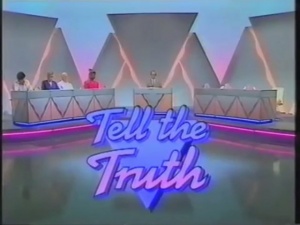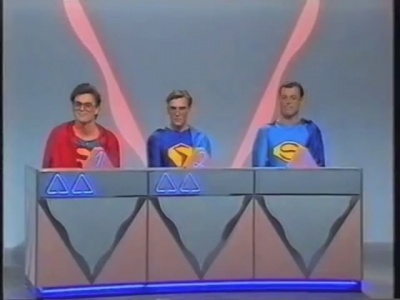Tell the Truth
Contents |
Host
MacDonald Hobley (1957-8)
David Jacobs (1959)
Shaw Taylor (1961)
Graeme Garden (1983-5)
Fred Dinenage (1989-90)
Co-hosts
Voiceover:
Robin Houston (1983-5)
Malcolm Brown (1989-90)
Broadcast
ATV (credited as "ATV by arrangement with Goodson and Todman and CBS") for ITV, 17 September 1957 to 6 September 1961 (76 episodes in 3 series)
LWT in association with Goodson-Todman Productions and Talbot Television for Channel 4, 17 April 1983 to 22 November 1985 (51 episodes in 4 series)
TVS in association with Mark Goodson Productions and Talbot Television for ITV, 11 April 1989 to 26 October 1990 (92 episodes in 3 series)
Synopsis
Four celebrities with some time on their hands and three apparent nobodies. Ah, but which nobody is the somebody... and can you spot the bad acting?
Yes, that's Tell the Truth. Four celebs come to play by asking questions of three protagonists, one of whom has a secret which they would like to reveal to the world. The two 'impostors' claim to share that secret too, and the celebs try to work out who the real one is. Each celeb gets 30 seconds to fire questions at whoever they like in the line-up, usually one or two for each of the three people.
Then the panel individually have to nominate (via numbered cards or, in higher-budget series, lit signs) who they think is telling the truth. Then comes the famous moment when the host asks "can the real ____ please stand up" at which point all three hilariously pretend to rise from their chair until only the truth-teller actually does so. Once the person telling the truth has been revealed, the host has a short interview on the subject, as well as revealing the real identities of the two impostors. It's not known whether the host is 'in' on the secret identity - if they are, they do a good job of disguising it.
In part 2, another three bodies appear claiming something different, and the show continues in the same vein. One of the few rules was that the celebrities could not ask the claimants to demonstrate their claim during questioning, such as asking a supposed town crier to go 'oyez, oyez'.
In the end game, One to One, the four impostors come back, as one of them has a different secret. This time, each one is individually questioned by a different celebrity, who decides whether or not he/she is telling the truth. After all four (rather brief) interrogations have happened, the truth-teller is revealed - usually leaving a gobsmacked celebrity, who would never have believed that he/she was the genuine article. In the instance that all four celebrities vote 'NO', the final celebrity receives one additional 'YES' vote to place on one of the suspects; however, rather than overruling the previous vote it counts as an additional guess, somewhat bafflingly. Maybe it's to avoid putting them in the position of rudely cancelling the vote of their fellow celeb.
The scoring system was rather loose to the point of practically non-existent. Apart from a vague sense of whether the panel had done well or not, there was no real attempt to keep any kind of points, and perhaps that was a weakness in in the format.
Something of a hardy perennial, the show swapped channels twice though never really took root. However, in terms of suspense it was hard to beat.
Catchphrases
(At the beginning of the show): "Number One, what is your name, please?" This was repeated with Number Two and Number Three, and when all three had claimed to be a certain person: "Only one of these people is the real (whoever) and has sworn to tell the truth (or, before the break, "....And in Part Two, we'll find out which one has sworn to tell the truth").
"It's 'make your mind up' time for our panel - and for you at home - is it Number One - or Number Two - or could it be Number Three?"
"Right, team - there's an envelope in front of you all with a sworn statement inside it - open it up - I'll read it to you..."
"That's the name and that's the claim"
"Will the real (whoever) please...stand up?" or, "...Now let's find out who's right and who's wrong as I ask the real (whoever) to please...stand up?"
(Fred Dinenage, if a contestant was prevented from answering a question by the 'time's up' buzzer): "We shall never know!"
Inventor
Based on a Goodson-Todman format created by Bob Stewart.
Trivia
Among the most regular guest panellists in the 1980's/90's version were Chris Tarrant, Claire Rayner, Bob Carolgees, Christopher Biggins, The Reverend Roger Royle, Bill Tidy, Beverley Anderson and Judi Spiers.
Among the notable contestants who appeared in the later series was Richard Crane (during the Garden-era), who would later host Survival Challenge for the BBC - his claim to fame being that he ran the Himalayas. Another (during the Dinenage-era this time) was the World War II telegraph operator, who was the first person to receive the news that the Germans had surrendered in 1945. He had previously appeared on I've Got a Secret.
We also saw the late, great Ivy Benson, the bandleader: all four panellists guessed correctly when it came to identifying her. There was also a man who was the loudest snorer in Britain: while he and the other three contestants were being questioned, much was made of how his wife put up with it. The answer was that she was a bit deaf in one ear.
Oh, and let's not forget the Dinenage-hosted edition in which the contestant in the final game was a knife-thrower. He duly demonstrated his act, with the inevitable twist that his assistant/target was unavailable, so Dinenage, much to his ill-concealed consternation, was forced to fulfill said role. Anyway, all went well and Dinenage survived the scary experience, but it left him drained and with little to say for himself at the end - and that took some doing.
The LWT series seems to be the only version to have all of its episodes survive from the archives as all of the episodes from the ATV series have been wiped and all the episodes from the TVS series are bought by Disney, with an amount of paperwork missing, meaning they can't be repeated.
Music
The Graeme Garden-era music was written by Nigel Hess.
Web links
See also
Odd One In, a 2010 reworking of the same idea.



